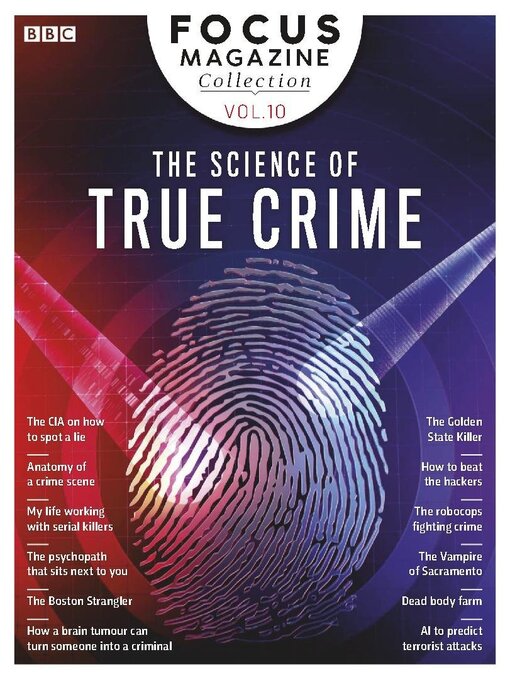This BBC Focus Special Edition reveals the cutting-edge techniques being used to catch criminals... IN THIS ISSUE… Understand how forensic science works How psychological profiling changed the FBI The DNA detectives solving unsolved crimes How brain injuries can create criminals Take a test to see if you are a psychopath How maths can help predict terrorist attacks Robocops: the future of crime fighting
Guilty pleasures
CRIME HOTSPOTS • YOU MIGHT THINK YOU KNOW WHERE TO AVOID IF YOU DON’T WANT TO BECOME A VICTIM OF CRIME. BUT, AS THIS WORLD MAP AND STATISTICS SHOW, CRIMINAL HOTSPOTS CAN SOMETIMES SURPRISE YOU…
FORENSIC SCIENCE • Scene-of-crime operatives in plastic overalls are a common sight on our TV screens. But what do they actually do?
JARGON BUSTER
WHAT WE STILL DON’T KNOW
EXPLAIN IT TO A FRIEND
ANATOMY OF A MODERN CRIME SCENE • A man has been found murdered in a suburban home. The killer may have got away, but forensic scientists have plenty of evidence to pore over…
ON THE BODY FARM • Corpses can tell you a lot. Just like language, decomposition is dependent on location. Which is why some researchers say we need to start studying the dialect of decay in the UK
BREAKDOWN • Left unburied and uncovered, here’s what happens to a body…
OTHER THINGS TO DO WHEN YOU’RE DEAD • Donating your body to medical science is one way to make yourself useful after death. But here are some less run-of-the-mill options…
DNA Detectives • Law enforcement agencies have started investigating unsolved crimes by combining DNA databases and family trees. But should ‘genetic genealogy’ really be used to crack cold cases?
GENETIC VARIANTS • The human genome is our complete set of 23 chromosomes. It’s made from DNA and is over three billion letters long. The differences between individuals can be found at locations that commonly vary between us – genetic variants. Here are three different types that are used to compare people
HOW IT WORKS • Identifying the perpetrator of a crime using DNA databases and family trees
GENETIC MUGSHOTS • DNA found at crime scenes can also provide clues through ‘genetic phenotyping’ – where physical descriptions and photofit images are reverse engineered from recovered material. Parabon, the company that cracked ‘cold cases’ with genetic genealogy, says it can predict a suspect’s genetic ancestry and what they look like. Here are some cases they’ve worked on…
THE PSYCHOPATHS AMONG US • Despite what Hollywood suggests, psychopaths aren’t easy to recognise, since they’re rarely seen brandishing blood-soaked axes while leering maniacally. So how can you spot a psychopath? And could you be working alongside one right now?
HOW TO SPOT A PSYCHOPATH • Here are some signs to look out for…
CAN PSYCHOPATHS BE TREATED? • There’s no ‘cure’, but research suggests psychopathy can be made more manageable… if it’s caught early enough
Is your boss a PSYCHOPATH?
Jon Ronson • The author of So You’ve Been Publicly Shamed discusses his journey into madness and the psychopaths he met while researching his 2012 book The Psychopath Test
CATCHING CROOKS • How the advent of psychological profiling revolutionised police investigations, helping to catch some of the world’s most notorious criminals
CAN PROFILING BE USED TO CATCH TERRORISTS?
5 CASES CRACKED WITH CRIMINAL PROFILING
THE TRUTH WILL OUT • FORMER CIA OFFICER PHILIP HOUSTON REVEALS HOW TO GET ANYONE TO TELL YOU THE TRUTH
WHAT MAKES SOMEONE MORE LIKELY TO LIE?
5 STEPS TO GET ANYONE TO TELL YOU THE TRUTH
MY BRAIN MADE ME DO IT • A head injury or brain tumour can radically change someone’s personality – in severe cases causing them to commit atrocious crimes. How can...
